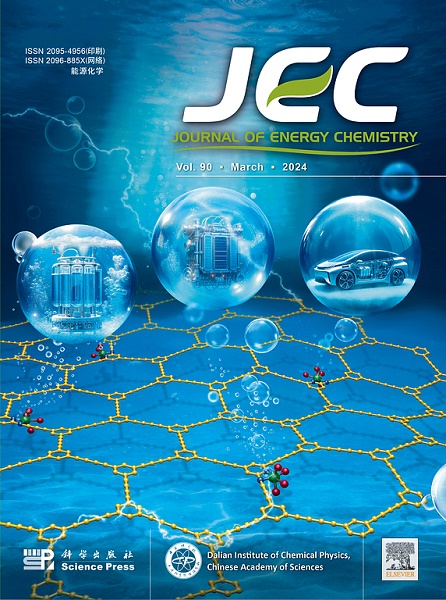聚合物基全固态锂金属电池体离子传导和界面化学的协同调制
IF 13.1
1区 化学
Q1 Energy
引用次数: 0
摘要
固体聚合物电解质(spe)因其易于加工而被认为是全固态锂金属电池(asslmb)最有前途的材料之一。然而,开发具有高离子电导率和界面稳定性的spe仍然是一个挑战。本文引入一种类似于供体-受体(D-A)的固体增塑剂,三(五氟苯基)硼烷(TPFPB),它含有富电子的F原子和缺电子的B位点,以调节聚乙烯氧化物(PEO)基spe的离子传输行为和界面化学。由于TPFPB分子与Li盐之间的多重离子偶极相互作用(F··Li+··TFSI−和B··TFSI−··Li+),形成了具有更多自由Li+和捕获TFSI−阴离子的多模态电解质环境,与PEO结晶度降低相配合,显著促进了Li+的快速迁移。更重要的是,TPFPB倾向于优先还原,在锂金属阳极上形成稳定的富无机固体电解质界面,确保均匀的锂镀/剥离行为。因此,tpfpb调制的spe体系实现了0.74 mS cm−1的高Li+电导率,并有效抑制了枝晶的生长,从而实现了超过5000 h的长周期无枝晶Li/Li对称电池,并且在实际运行的asslmb中进一步验证了其卓越的电化学性能。这项工作的发现将激励人们努力开发用于全固态碱金属电池的高性能spe。本文章由计算机程序翻译,如有差异,请以英文原文为准。

Synergetic modulation of bulk ion conduction and interface chemistry in polymer-based all-solid-state lithium metal batteries
Solid polymer electrolytes (SPEs) are considered one of the most promising materials for all-solid-state lithium metal batteries (ASSLMBs) due to their facile processability. However, developing SPEs with both high ionic conductivity and interfacial stability remains a challenge. Here, a donor–acceptor (D-A) like solid plasticizer, tris(pentafluorophenyl)borane (TPFPB), containing electron-rich F atoms and electron-deficient B sites, was introduced to regulate the ion transport behavior and interfacial chemistry of polyethylene oxide (PEO)-based SPEs. Owing to the multiple ion–dipole interactions (F‧‧‧Li+‧‧‧TFSI− and B‧‧‧TFSI−‧‧‧Li+) between the TPFPB molecule and Li salts, a multimodal electrolyte environment featuring more free Li+ and trapped TFSI− anions was generated, which cooperates with the reduced crystallinity of PEO, significantly facilitating the rapid migration of Li+. More importantly, TPFPB tends to be preferentially reduced to form a stable inorganic-rich solid electrolyte interphase on the Li-metal anode, ensuring uniform Li plating/stripping behavior. Thus, the TPFPB-modulated SPEs system achieves a high Li+ conductivity of 0.74 mS cm−1 and effectively suppresses dendrite growth, which enables a long-cycle dendrite-free Li/Li symmetric cell for over 5000 h, and remarkable electrochemical performance has been further validated in operational ASSLMBs. The findings in this work would inspire efforts to develop high-performance SPEs for all-solid-state alkali-metal batteries.
求助全文
通过发布文献求助,成功后即可免费获取论文全文。
去求助
来源期刊

Journal of Energy Chemistry
CHEMISTRY, APPLIED-CHEMISTRY, PHYSICAL
CiteScore
19.10
自引率
8.40%
发文量
3631
审稿时长
15 days
期刊介绍:
The Journal of Energy Chemistry, the official publication of Science Press and the Dalian Institute of Chemical Physics, Chinese Academy of Sciences, serves as a platform for reporting creative research and innovative applications in energy chemistry. It mainly reports on creative researches and innovative applications of chemical conversions of fossil energy, carbon dioxide, electrochemical energy and hydrogen energy, as well as the conversions of biomass and solar energy related with chemical issues to promote academic exchanges in the field of energy chemistry and to accelerate the exploration, research and development of energy science and technologies.
This journal focuses on original research papers covering various topics within energy chemistry worldwide, including:
Optimized utilization of fossil energy
Hydrogen energy
Conversion and storage of electrochemical energy
Capture, storage, and chemical conversion of carbon dioxide
Materials and nanotechnologies for energy conversion and storage
Chemistry in biomass conversion
Chemistry in the utilization of solar energy
 求助内容:
求助内容: 应助结果提醒方式:
应助结果提醒方式:


